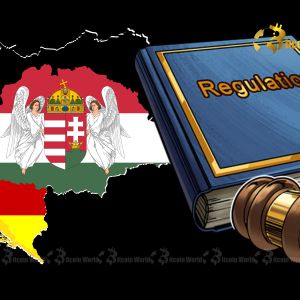Hungary’s Alarming Crypto Regulations: A Deep Dive into the Digital Asset Future
7 min read
BitcoinWorld Hungary’s Alarming Crypto Regulations: A Deep Dive into the Digital Asset Future The cryptocurrency world is no stranger to regulatory shifts, but Hungary’s latest move has sent shockwaves, raising serious questions about the future of digital assets within its borders and potentially beyond. On July 1, new stringent regulations came into effect, criminalizing unauthorized crypto transactions and services, with penalties as severe as two years in prison for even basic offenses. This dramatic shift, affecting an estimated 500,000 Hungarian citizens according to Forbes, places the nation’s burgeoning crypto community in a precarious legal gray area. The alarm bells are ringing louder still as Hungary’s approach diverges sharply from the European Union’s efforts towards a unified crypto framework, sparking fears of a significant exodus of crypto businesses. Hungary Crypto Regulations: An Unprecedented Clampdown? Hungary’s recent legislative action marks a significant departure from the more cautious, yet increasingly clear, regulatory paths taken by many other nations. The new laws, effective since the start of July, introduce a harsh stance on activities previously operating in a less defined space. At its core, the legislation targets “unauthorized” cryptocurrency transactions and services. This isn’t merely about taxation or licensing; it’s about outright criminalization, potentially leading to jail time for individuals engaging in activities that might be considered routine elsewhere. Consider the gravity of the situation: Criminalization: Unlike many countries focusing on consumer protection or anti-money laundering (AML) compliance, Hungary’s rules criminalize certain crypto activities directly. Harsh Penalties: Even for what are termed “basic offenses,” individuals could face up to two years in prison. This level of punitive measure is rare in the global crypto regulatory landscape. Widespread Impact: With half a million citizens estimated to be involved in crypto, the potential for widespread disruption and legal entanglement is immense. The immediate consequence is a pervasive sense of uncertainty. What exactly constitutes an “unauthorized” transaction? The vagueness of the guidelines is perhaps the most unsettling aspect, leaving both businesses and individual users struggling to interpret and comply with the new Hungary crypto regulations. The Scope of Hungary’s Crypto Crackdown: Navigating the Legal Gray Area The term “crypto crackdown” perfectly encapsulates the severity of Hungary’s new stance. But what precisely does this mean for the everyday user or the innovative startup? The legislation broadly criminalizes “unauthorized transactions and services.” This phrasing is critically ambiguous. Does it apply to: Operating an unregistered crypto exchange? Providing crypto-related financial advice without specific licenses? Simply trading cryptocurrencies peer-to-peer without reporting to a central authority? Using crypto for payments in everyday transactions? Without clear definitions and specific examples, the crypto community in Hungary is left guessing. This ambiguity creates a dangerous “legal gray area” where individuals and businesses might inadvertently break the law, unaware they are doing so. For instance, if a Hungarian citizen uses a foreign-based, unregulated exchange for trading, are they liable? If they receive crypto as payment for freelance work, is that considered an unauthorized transaction? The lack of clarity poses a significant threat to legal certainty and economic stability within the digital asset sector. This stringent approach contrasts sharply with the global trend towards regulating, rather than outright criminalizing, digital asset activities. Most jurisdictions aim to integrate crypto into existing financial frameworks, focusing on AML, counter-terrorist financing (CTF), and consumer protection, often through licensing and registration requirements. Hungary’s crypto crackdown, however, seems to take a more prohibitive route, potentially stifling innovation and driving crypto activity underground. How Does This Compare to EU MiCA? Understanding the Divergence One of the most significant concerns stemming from Hungary’s new rules is its apparent divergence from the European Union’s landmark Markets in Crypto-Assets (MiCA) regulation. MiCA, adopted in April 2023 and set to be fully implemented by late 2024/early 2025, aims to create a unified and harmonized regulatory framework for crypto-assets across all 27 EU member states. Its primary goals include: Consumer Protection: Safeguarding users from risks associated with crypto assets. Market Integrity: Preventing market abuse and ensuring transparency. Financial Stability: Mitigating risks to the broader financial system. Innovation Promotion: Providing legal certainty to foster responsible development of crypto technologies. MiCA focuses on licensing crypto-asset service providers (CASPs), requiring them to meet strict operational, governance, and capital requirements. It provides clarity on various crypto-asset categories (e.g., e-money tokens, asset-referenced tokens) and sets rules for their issuance and trading. The spirit of MiCA is to regulate, legitimize, and integrate crypto into the financial system, rather than criminalize it. Hungary’s unilateral criminalization, however, appears to be a stark contrast. While specific details of how Hungary’s new laws interact with MiCA are yet to be fully elucidated, the immediate effect is a fragmentation of the EU’s single market for crypto. If businesses operating under MiCA licenses in other EU countries face criminal charges in Hungary for similar activities, it undermines the very principle of a unified framework. This divergence creates a complex legal landscape for businesses operating across EU borders and could deter international crypto firms from considering Hungary as a viable market, impacting the broader EU MiCA vision. Navigating the Cryptocurrency Legal Landscape in Hungary: Challenges and Pathways For the half-million Hungarian citizens and numerous crypto businesses, the new cryptocurrency legal landscape presents formidable challenges. The most immediate is the threat of legal repercussions for what might have previously been considered standard practice. Businesses face an existential crisis: adapt to highly restrictive and vague laws, or leave. Key Challenges: Legal Uncertainty: The lack of clear definitions makes compliance extremely difficult. Business Exodus: Crypto companies thrive on innovation and regulatory clarity. Hungary’s stance could force them to relocate to more crypto-friendly jurisdictions. Reduced Innovation: A punitive environment stifles new projects and talent, hindering the growth of a local crypto ecosystem. User Fear: Individuals might withdraw from legitimate crypto activities, pushing transactions into less transparent channels. Actionable Insights for Individuals and Businesses: In this challenging environment, proactive measures are crucial: Category Actionable Insight For Individuals Seek Legal Counsel: Consult with legal experts specializing in Hungarian and EU crypto law to understand personal exposure and compliance requirements. Understand Your Activities: Categorize your crypto activities (trading, mining, payments, staking, etc.) and assess their legality under the new rules. Consider Compliance: If possible, engage only with regulated entities, even if foreign-based, that have a clear legal standing. Stay Informed: Follow official announcements and legal interpretations closely, as guidelines may evolve. For Businesses Legal Review: Conduct a thorough legal review of all operations and services offered within Hungary. Compliance Framework: Develop a robust internal compliance framework that attempts to address the new regulations, however vague. Strategic Re-evaluation: Assess the viability of continued operations in Hungary. Explore relocation to other EU member states that offer clearer, MiCA-aligned frameworks. Advocacy: Engage with industry associations and policymakers to advocate for clearer, more balanced regulations. The path forward for the cryptocurrency legal sector in Hungary is fraught with difficulty, requiring careful navigation and potentially significant operational changes. The Digital Asset Future: A Precedent for Other Nations? Hungary’s aggressive regulatory stance raises a critical question for the broader digital asset future: will this become a precedent for other nations, or will it serve as a cautionary tale? The global regulatory landscape for cryptocurrencies is still evolving, with countries experimenting with various approaches ranging from outright bans to embracing innovation through sandbox environments and clear licensing regimes. There is an ongoing philosophical debate at play: Innovation vs. Control: How much control should governments exert over a decentralized technology that promises financial freedom and innovation? Consumer Protection vs. Over-regulation: At what point does regulation become so stifling that it drives legitimate activity underground or offshore? National Sovereignty vs. Global Harmonization: Should each nation forge its own path, or is a unified global approach necessary for an inherently borderless technology? Hungary’s decision to criminalize certain activities places it firmly on the side of aggressive control, potentially prioritizing perceived risks over the benefits of digital asset innovation. While the EU is striving for harmonization with MiCA, individual member states like Hungary demonstrate that national interpretations and priorities can still lead to significant fragmentation. The long-term impact on Hungary’s economy, its reputation as an innovation hub, and the welfare of its crypto-savvy citizens remains to be seen. The digital asset future depends heavily on how governments balance the need for stability and protection with the imperative to foster technological advancement. Hungary’s move will undoubtedly be watched closely by policymakers worldwide, serving as a real-world case study in the complex dance between regulation and revolution. Summary: A Critical Juncture for Hungary’s Crypto Landscape Hungary’s new cryptocurrency regulations represent a significant and concerning development for the global digital asset community. By criminalizing unauthorized transactions and services, and imposing severe penalties, Hungary has adopted one of the strictest approaches seen in Europe. This move not only puts an estimated half a million Hungarian citizens at risk but also creates a jarring divergence from the EU’s unified MiCA framework, threatening to isolate Hungary’s crypto sector and trigger a business exodus. The vague guidelines further exacerbate the uncertainty, leaving businesses and individuals navigating a perilous legal gray area. As the world watches, Hungary’s decision serves as a stark reminder of the unpredictable nature of crypto regulation and the critical need for clear, balanced, and harmonized laws that foster innovation while protecting users. The future of digital assets in Hungary, and potentially beyond, hinges on how these unprecedented measures are enforced and whether clarity can eventually prevail over ambiguity. To learn more about the latest crypto market trends, explore our article on key developments shaping cryptocurrency legal frameworks and institutional adoption. This post Hungary’s Alarming Crypto Regulations: A Deep Dive into the Digital Asset Future first appeared on BitcoinWorld and is written by Editorial Team

Source: Bitcoin World



